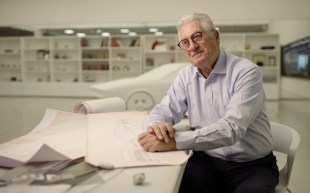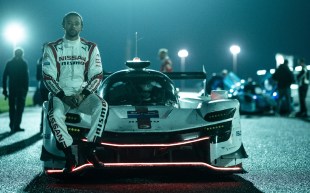Andy Green Q&A: What it's like to drive Bloodhound LSR at up to 628mph
And the team still hasn't fitted its rocket engine
THE BLOODHOUND LSR team is packing up after a testing programme in South Africa’s Kalahari Desert that saw Wing Commander Andy Green pilot the jet car to 628mph, in preparation for a new world land speed record attempt in 2020 or 2021.
Green and his engineers, based in a large tent next to the start of the 10-mile track (which had been cleared of 16,500 tonnes of rock from 22 million square metres of dry lake bed by 317 members of the local Mier community) had increased the speed of the Bloodhound LSR gradually during the course of the four-week programme, testing systems including brakes and parachutes, and checking stability and drag as velocity increased.
At one point, when the car reached 491mph for the first time, a steel component was folded by airflow at the front wheels, forcing the team to make what Green described as “a quick and dirty fix” in the field.
What I like about @Bloodhound_LSR is that every day for the last 12 years I’ve been presented with a new problem to solve… what I love about @Bloodhound_LSR is I can share it.. #Engineering (this steel was folded by airflow from the front wheels at 800kmh) #2019HST pic.twitter.com/GIGOPd0VpG
— Mark Chapman (@MChapman1050) November 5, 2019
During Green’s 628mph run, the EJ200 jet engine — lifted from a Eurofighter Typhoon fighter plane — generated 9kN of thrust, roughly equal to 54,000bhp or the combined output of 360 family cars.
Data from 192 pressure sensors on the car showed airflow beneath the car went supersonic, stripping the paint from an area three meters behind the front wheels.

The jet engine alone is not enough to take the Bloodhound LSR to the current world land speed record of 763mph, which was set by Green in Thrust SSC (which employed two jet engines) in 1997. To break the record, a Nammo rocket engine will be added to the car, with a potential top speed of more than 1,000mph.
Bloodhound says its engineers are working with Associate Professor Ben Evans and Jack Townsend from Swansea University to examine the testing data, and the drag created, which will help determine the size of the rocket that will be fitted to the car for the attempt to set a new world land speed record in 12 to 18 months’ time.
Andy Green Q&A
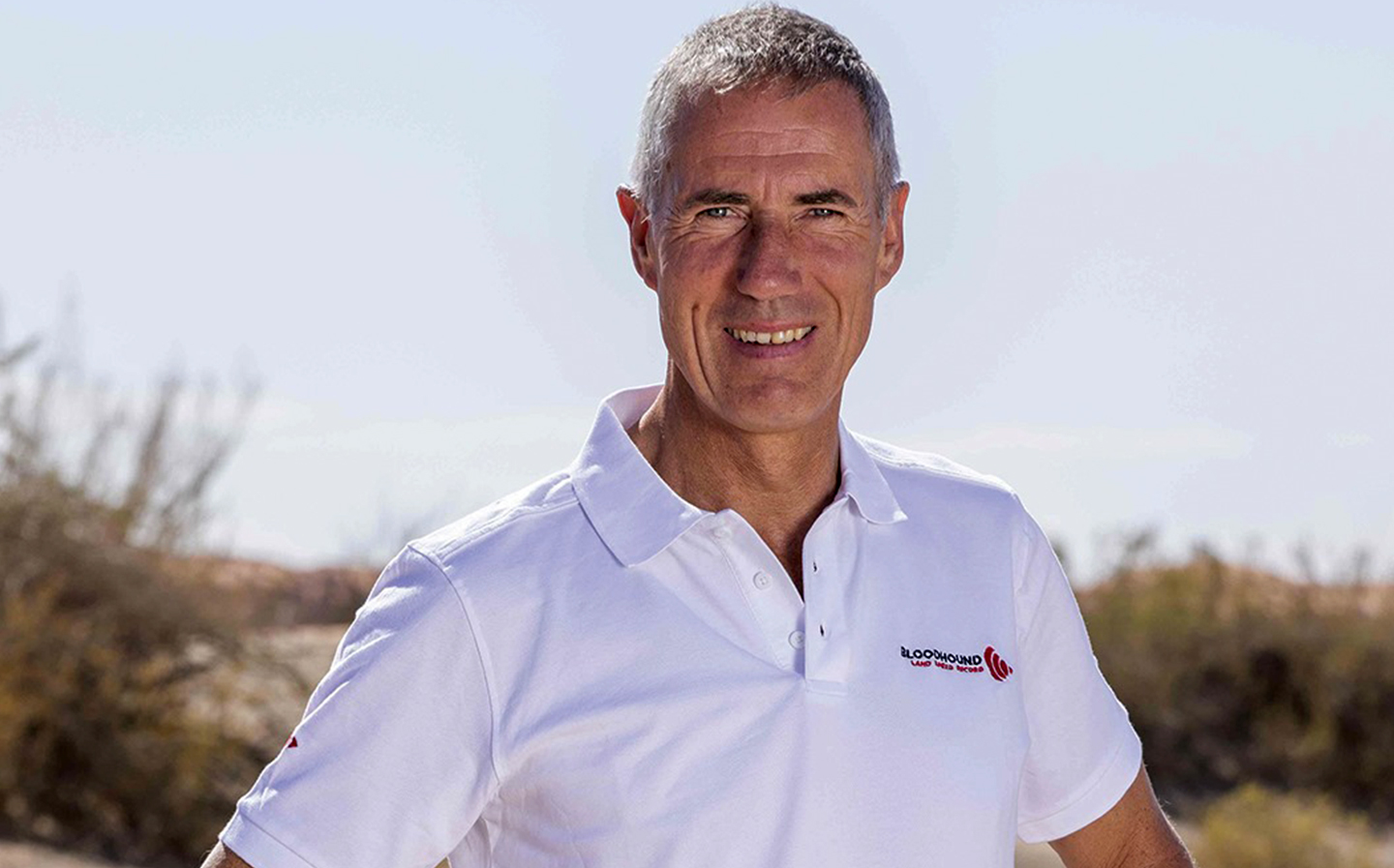
We caught up with Green via telephone half way through his testing programme in South Africa. He’d already exceeded 500mph and had managed successful braking tests, with double parachute deployment, but had not yet reached 600mph+. The car was already a handful, clearly.
Aside from asking Green what Bloodhound LSR is like to drive, we wanted to know how much of a concern to him was the shearing off of a piece of bodywork at high speed. We also asked whether crashing crosses his mind and what his wife makes of the whole thing.
We asked him if it would be possible — and logical — to create an autonomous land speed record car, which would remove the risk to human life, and what Green thought about the idea.
And finally we asked if he’d recently spoken with Richard Noble, who piloted Thrust 2 to a new world land speed record of 633.468mph in 1983, and was the mastermind behind the Thrust SSC and Bloundhound SSC (now Bloodhound LSR) projects. Noble is no longer in charge of Bloodhound but is expected to continue to work on its educational programme.
Will Dron: Can you describe how it feels to drive Bloodhound at more than 500mph?
Andy Green: The obvious thing to say is that the ground passes by very quickly. But it’s astonishing — it just keeps getting faster and faster and faster. I remember very clearly doing that in the Thrust SSC, 22 years ago now, but it’s still amazing the performance of a car like this; that the acceleration just keeps coming for as long as you keep your foot in it.
The other surprising thing is how light the car gets directionally. We had theorised that as the car accelerated, the wheels would gradually rise up like boat hulls on the plain, and the contact patch would gradually get smaller and smaller, and the mechanical — the lateral grip — of the wheels would gradually get less. Mechanical grip and normal race car tyres create downward speed, and then if you start on a slippery surface in the desert, you reduce that mechanical grip. So we were expecting the car would gradually get more and more slippery until the aerodynamics kick in at 500mph plus.
The big surprise for me when we started driving this car is that this is a really obvious effect, and it’s down at around 250mph — the car actually starts to float around. It’s literally like taking a normal race car, driving across hard-packed snow, and suddenly driving on to sheet ice at 200 miles an hour.
You have to almost change your driving technique completely because the car is handling such a different way. Having had several practices at that now, I’m getting the hang of keeping the car straight, but because there’s so little mechanical grip, if there’s a gust of crosswind, which we have had, it will push the car offline and then I’ll have to work quite hard to actually correct it, get it back on line and sorted out.
“At around 250mph, the car starts to float around. It’s like driving a normal race car across hard-packed snow and suddenly driving on to sheet ice”
So it’s learning and evolving the driving technique all the time and changing that, depending on the environmental conditions, literally from second to second. Because out in the desert, you don’t get a steady, even wind all the time, you get a lot of thermal winds — you get an area where you get a bubble of hot air rising, and you’ll suddenly get a rush of air. No apparent warning, it’ll just happen.
And that happens in the middle of a run, and with little grip, I’ve got to actually work quite hard. You’ll see on some of the cockpit videos, I’m working the steering wheel quite hard just to control the car as it’s slicing through these crosswinds at 500 miles an hour.
WD: Christ. I remember the videos of you in Thrust SSC, steering hard to keep it straight — there’s quite a lot going on. Does the desert surface make a difference? Is it softer than the salt pan at Bonneville?
AG: This is actually a harder surface, which is good in terms of the load bearing, the consistency and the control of the vehicle vertically, which is the really important bit, but it actually does make it slightly more challenging to correct it laterally, either to get the steering responses and the mechanical grip laterally from the wheels.
It’s not unmanageable, but it does give us a relatively low crosswind limit, so we’re working to a crosswind limit at the moment of 10mph, and that that seems to be a fairly sensible limit.
WD: What will it be like it 700+ miles an hour?
AG: Well, what I’m hoping is that the aerodynamic grip and stability will then come up and that will then aid the control and stability at high speed. Of course, the wheels are then still controlling the car but they are now controlling it by deflecting the airflow around the wheels, so they’re actually becoming aerodynamic devices rather than, you know, the mechanical wheel effect that you’re used to on a normal race car.
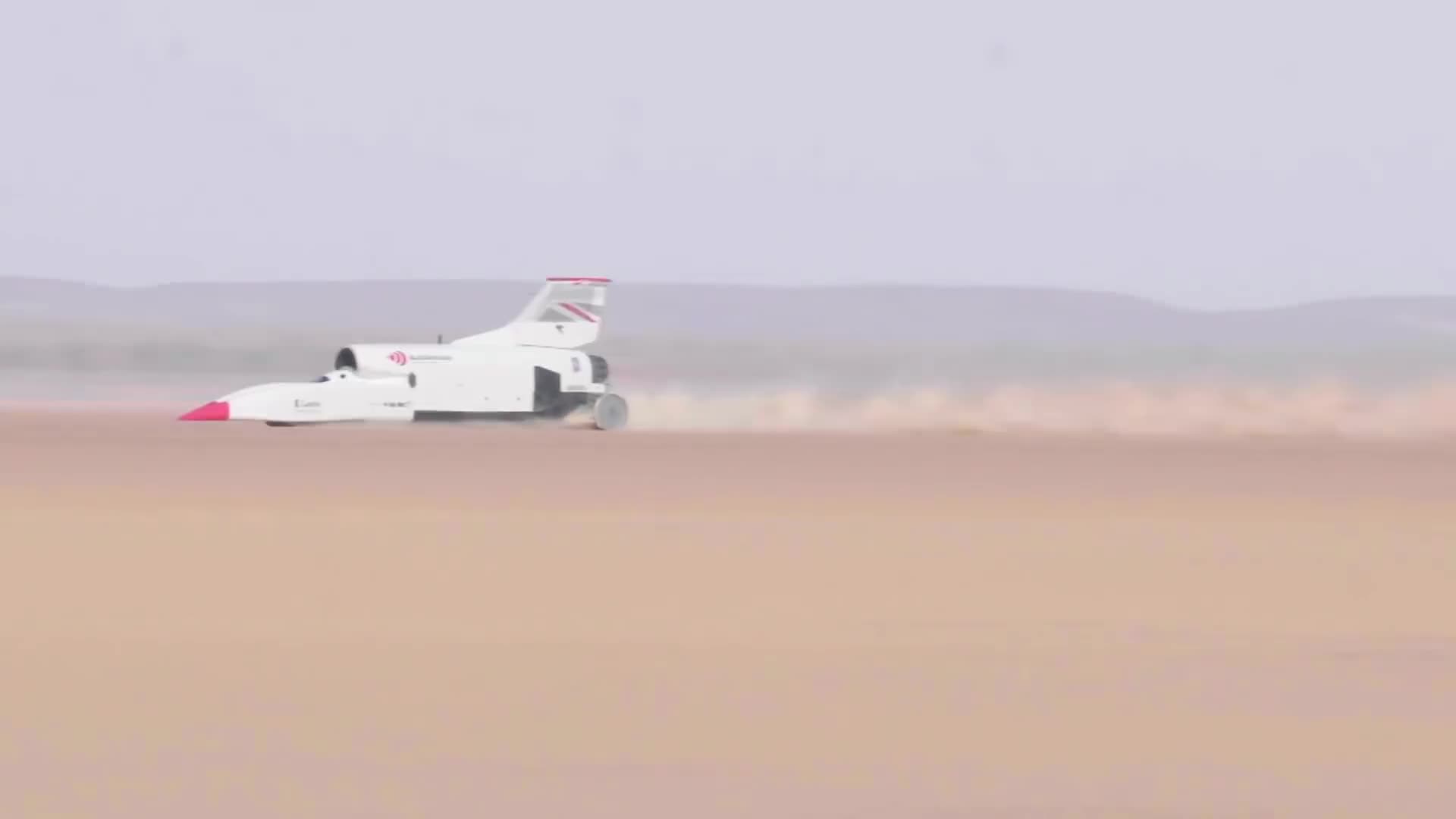
WD: Do you need the rocket to reach the record of 763mph?
AG: Yes, we do. And we’ve actually got the Nammo [rocket-making] team out this week, who are looking at the practical issues. We will obviously collect a huge amount of performance data that will define how powerful the rocket needs to be and the sort of pressure field it has to operate in at the back of the car, which in turn, Nammo needs to understand to design the nozzle for maximum efficiency. But they’re also looking at the practicalities of being out in the desert: how much refrigeration the rocket oxidiser is going to need, and how we’re actually going to keep the monopropellant — hydrogen peroxide — how we’re going to keep that clean, so that we don’t get any contamination in it. We want it to be a well-behaved liquid. So we’re very much taking a first look at how we’re going to do this next year.
WD: Okay, and the target is just the record, for the moment, isn’t it, rather than 1,000mph?
AG: Yeah, absolutely. The initial target — phase one of the programme — is to beat the current world record. Basically we’re targeting an 800mph record over the next year or so.
Depending on how that goes, we will then look at the technical practicalities of how much faster we can make the car go, because we’ll have some real supersonic data then. Nammo are also developing their next generation of hybrid rocket, so the rocket technology is very much still in development over the next year or two; that’s something they’re making right now.
And of course, it will also depend on the enthusiasm of the sponsors. You know, if they think that’s absolutely brilliant, we gotta go for 1,000mph, great. If they said well, actually, 800mph and a land speed record has already gone global, and that’s achieved the effect in terms of getting the global promotion, and getting the global message about science and technology out there to a generation of young people; if we’ve already achieved that, then that’s the job of the car pretty much done.
WD: Does the bodywork failure concern you, or is that all part of the testing?
AG: No, not at all — it’s all part of the testing. Thrust SSC had little bits of body work fail. And we had a lot of extra material out there; we were manufacturing extra body panels and repairing bits. By comparison, this car has actually done really well.
And to quote Mark Chapman, our chief engineer, he and I were chatting about it earlier, when we were looking at the patch repair we’d put on, before we ran it, he said, “If this is the worst problem we have out here, I will be so pleased.”
Andy Green went past 500mph today in @Bloodhound_LSR. He did so after a part sheared off yesterday due to punishment at that speed, and a replacement was manufactured by a bloke on-site at Hakskeen Pan. Green has balls so large, Atlas couldn’t carry them on his back. pic.twitter.com/A3WSq5AR31
— Will Dron (@wdron) November 6, 2019
Now, one of the first things that he and I went to look at when I got out of the car the day after was the same patch repair at the leading edge of the Delta — it was almost unmarked. The guys had done a brilliant job of fabricating something in 24 hours that appears to have cured the problem.
Of course, we still monitor it — it may still need a bit more work — but they modified the car in the field, hand manufactured and hand-shaped some bits and secured them, and appear to have done a fabulous job.
WD: Is it a steel patch?
AG: Yes, they used a mild steel patch. We have better materials out here — heavier gauge material — we just don’t have the shaping capability to do that sort of compound shape with them. And it would take longer. So as a quick and dirty fix to the problem while we finish the testing, it’s been a brilliant solution.
WD: Are you concerned about a worst case scenario? As in a crash?
AG: Frankly, no. Simply because there is so much care being put into every single thing. For instance, the bodywork is stripped off the car pretty much every other day and they’re borescoping the front wheels and bearings and all the witness marks to make sure that it not only looks perfect in there but, you know, all the bolts are exactly where we left them, torqued up exactly right.
“Because my wife has seen the engineering, she’s met these guys, she knows how carefully we are all looking after each other out here, she’s one of the biggest fans of the project”
So the level of detail and checking that goes on this car has to be seen to be believed. It’s been far better looked after than any aeroplane I’ve ever flown.
WD: Of course, it’s an inherently dangerous pursuit and that’s why it’s so exciting in many ways, aside from the engineering, but is this something you’ve discussed with your wife?
AG: Yeah. My wife was out here last week and she was the most excited person out here. The guys all came back in and said, “Your wife started to jump up and down and cheering as the car went past.
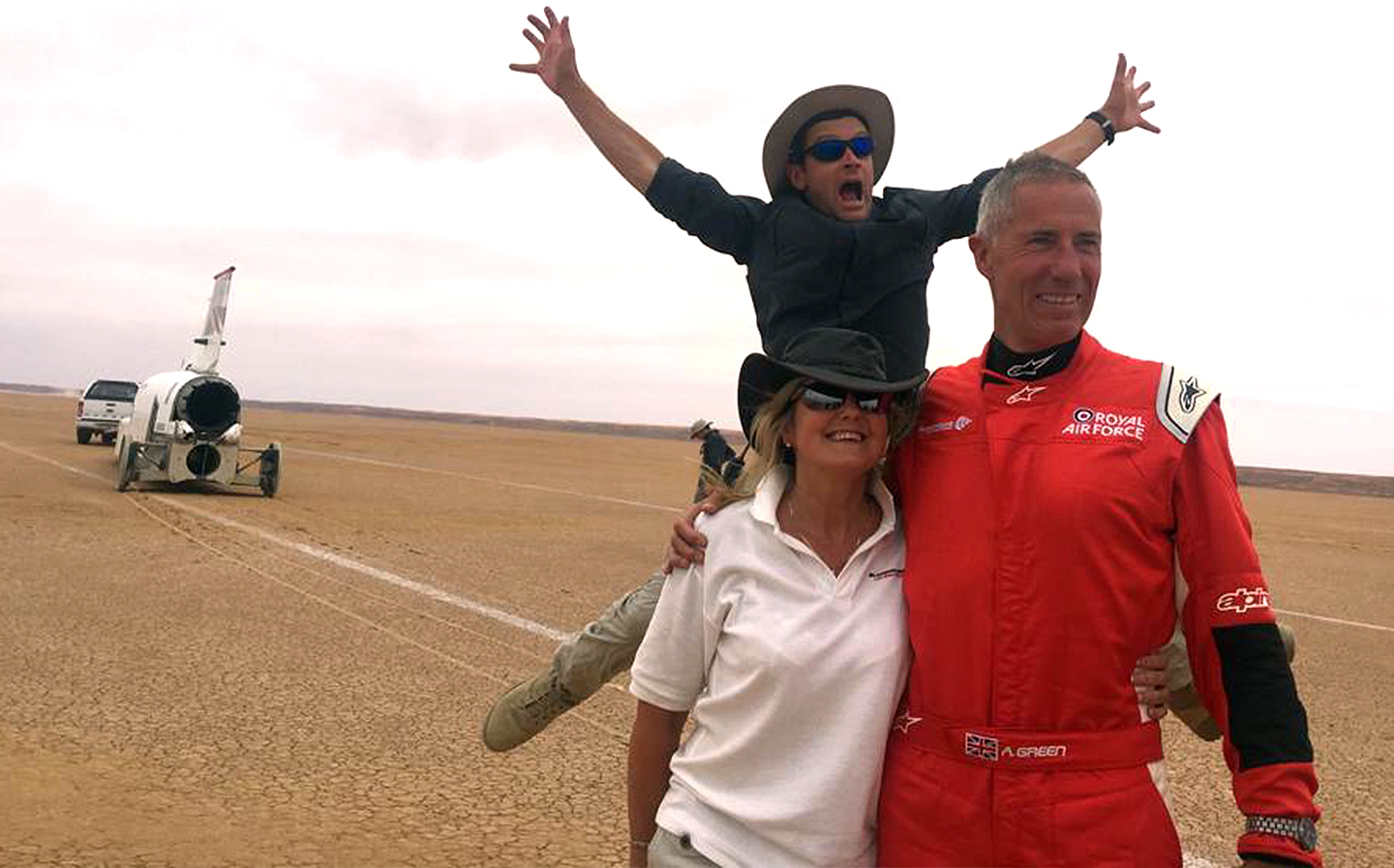
Again, because she’s seen the engineering, she’s met these guys, she knows how carefully we are all looking after each other out here. So she’s one of the biggest fans of the project.
WD: You’ve married the right person by the sounds of it.
AG: Absolutely.
WD: Have you got any thoughts on whether the land speed record car could be autonomous? I mean, could we conceivably do this without putting a human car?
AG: Right, here’s a question I’ve asked lots of people lots of times: Do you watch Formula One?
WD: Yes.
AG: If they were unmanned, autonomous cars, and there was nobody on the pit wall and nobody in the garage and they were just computer cars racing each other, would you bother to watch?
WD: I mean, it’s a difficult one, isn’t it? I’ve spoken to people at Roborace who think that people will because it’s do with AI, but I can see what you mean.
AG: Now come on, Will, you haven’t answered the question! Would you watch?
WD: I’d probably watch one and see how it goes. And maybe it might not be that interesting. The human element is definitely… I know what you’re saying.
AG: It’s a human endeavour story, and it’s not just about the drivers, it’s about the interaction between them. Everybody loves to hear Lewis [Hamilton] talking to Bono [Peter Bonnington, his race engineer] or vice versa, and thinking “Ooh, blimey his race engineer is away for a couple of races having an operation…” We all know all of that because they were talking about it. It’s the human relationships.
“Racing is a human endeavour story. It’s not just about highly technical cars that are built of unobtainium and cost a billion pounds an ounce. It’s about the people”
And the pit stops in two seconds and all sorts of ridiculous stuff … how do they do that? Watching the choreography; watching the people do it. It’s the people. Ultimately, racing is a human endeavour story, it’s not just about really, really highly technical cars that are built of unobtainium, that costs a billion pounds an ounce. It’s about the people. And the land speed record is exactly the same. It is just a story about human endeavour, about people doing stuff that hasn’t been done, and a lot of people said can’t be done.
We were told 22 years ago, “You can’t drive a car supersonic — it will definitely crash.” Well, Ron Ayers [chief aerodynamicist] found a way of designing a car; the rest of the guys found a way of building it; we found a way of actually setting the first and still only supersonic land speed record.
We’ve also been told it’s impossible to go to 1,000 miles an hour, but we’ve built a car that is now taking the steps in that direction. And it’s the human story of the people, ultimately, that we’re telling.
So forget the fact that the FIA regulations require an onboard driver to control the car and do two runs within one hour; forget the fact that it’s pretty nearly impossible to build a computer to do something like this totally reliably, that you can guarantee would never get confused and, you know, take a dive off the track and plough into a crowd — how could you prove that the computer won’t do that when you haven’t tested it?
But the most important thing is, why would you be doing this in the first place? Motor racing is about people. It’s about human competition, like all other sports. Even robotic sports like … and I forget that silly programme where they’ve got robots fighting … robots smashing each other up in a pen …
WD: Robot Wars?
AG: Robot Wars, yeah — even that is more about the people building and operating the robots than actually the robots fighting each other. If that was just a few robots coming out and smashing each other, I would never even have heard of it, I don’t think. Certainly wouldn’t have watched it.
WD: What’s the plan over winter?
AG: Analyse the data, analyse the aerodynamics, look at how we’re going to develop and build the Mark II Bloodhound, with its rocket pack. And understand all the stuff that we have learned here and all the things we can learn from the data when we get back.
And, of course, build the partnerships both here in South Africa and back in the UK, for the companies that actually see the benefit of being associated with a global icon like the world’s fastest car.
WD: Do you expect the Mark II Bloodhound to be substantially different, other than having a rocket strapped to it?
AG: No. I think the car we have now is so good that we are going to need very few changes. I will confidently predict that we aren’t going to need to change very much.
WD: What’s your planned return date to Hakskeen Pan?
AG: That will depend on a range of things, including what we determine as being the best weather, how long the rocket programme takes, and that will also have to fit in with Nammo’s other development work. They are the world’s best at what they do but they’re a fairly small company, so we do actually need to work in around their other projects. Because, you know, their proper paying work for the European Space Agency and others clearly has to take priority.
So I can’t answer that question right now. We’d like to be back here inside a year, it may take a little longer, we’ll see.
WD: Is Ian Warhurst [who rescued the Bloodhound project from bankruptcy and is its CEO] out there with you? How hands on is he?
AG: The Warhurst family have had a real revelation here. He is here all the time. I’m looking at him right now, just the other side of the hangar. His wife came out with his three sons, and one of them is staying out here. He’s actually now working with the team as work experience, and the school is quite happy to let him, which is great. He’s actually doing a productive job out here.
Ian’s wife took two of the children home but flew back out to see some more runs with the car because, she said, “I’ve never been involved in anything like this. Ever.” So they are hugely, hugely enjoying their role and support in Bloodhound, which I’m absolutely thrilled about.
WD: Have you spoken to Richard Noble recently?
AG: Yes, I have. I spoke to Richard a couple of times over the last couple of weeks. He’s heavily involved in other projects but he’s also absolutely delighted to hear that the car and all the 10 years of work the Northern Cape has put into the track are all now coming together and producing such a good result.
WD: Is he likely to come out to to the final run, do you think?
AG: I don’t know is the answer. Knowing Richard, he could just turn up at any time!



